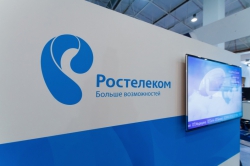Starting from this academic year, you’ll be teaching ‘Systems of Interdepartmental Electronic Interaction’ (SIEI) at ITMO University. Can you tell us more about the line-up of the course?
Students who will go on to work as IT specialists in the public sector, have to understand what awaits them. That’s why my principal aim is to provide them with insight into our long-standing experience of serving as a public sector IT provider. No less important are the technical aspects of such operations, so the course will also cover the fundamentals of SIEI, their main components, basic integration techniques and possible applications. SIEI is a sphere of dynamic development: although we’ve only just implemented SIEI 3.0, the switch to SIEI 4.0 is already up in the air as the concept has already been coined. The students have to be aware of these changes to apply their knowledge effectively.
It is also crucial to help them get a feel of the public sector’s IT distinctive ecosystem. When I first started working in the field, I was almost overwhelmed by the sheer amount of highly specific cases I had never seen before. That includes unique funding nuances, different legislation and so on. You also have to grasp the underlying principles of how the sector works to navigate your way around it, as well as be well-versed in the IT systems already present in the public sector to suggest meaningful improvements.
Speaking of SIEI: you were instrumental in building and modernizing the system. Which results of your work do you see as the most significant?
One of the most important results for me personally was that we contributed to a shift in people’s perceptions. The introduction of SIEI ushered in a new era of fuss-free e-services, where you no longer have to take a day off work and stand in kilometer-long lines to try and wade through the record-breaking amounts of red tape and get an official document or what have you. That also brought about the much-necessary tweaks in how civil servants operate: they had to switch from paper to modern technologies.
Our main task was to make the process as hi-tech as possible and bring the lever of change to the local level. In this we were first to start communicating with local officials via online chats: we would exchange information, sound out their needs, and get their suggestions and feedback. That was pivotal for ensuring the success of our product as no one knows how to make IT tools that address local problems better than people who work with these problems day in, day out.
Did you work with the IT side of things or perform a more management-like role?
I focused on management, but IT came into the picture quite often. My initial responsibility was building effective communications with regional and federal authorities, but then it shifted to being a leading product manager for the system we created: I was often approached by other state agencies to consult them on different schemes of electronic interaction. I also partook in drawing up and making amendments to the related legislation.
I couldn’t help but notice, though, that my line of work has this inherent bias towards management with its customer-provider contracted interaction patterns; perhaps that’s conditioned by the specifics of the public sector. But although we act on behalf of the government bodies when cooperating with IT companies to create a tailor-made product, we can’t allow ourselves to disregard all the technical aspects of such ‘order’. Although it doesn’t fit into the classical management paradigm, we have to ensure that the contractor in the form of an IT company gets exactly what a government body wants as a final result.
How to bridge these two sides who don’t often see eye to eye on how a project should be implemented? The secret is in visualizing each step of the process: it smooths out the possible divergence in interpretations. I’m also lucky in that although I’ve been working in IT for about 12 years, I’m a lawyer by education, and this helps me see the two sides of the coin.
What kind of work do you do at Rostelecom?
I look after the implementation of the Unified Biometric System (UBS) in Russia. It’s a system that combines voice and photo identification of people which is integral to the provision of services in the financial sector. All you have to do to get access to all the opportunities offered by every bank around the country is to pay one single visit to your local bank and complete the registration procedures.

The Unified Biometric System works in connection with the Integrated Identification and Authentication System (IIAS), which facilitates identity verification when logging into Russia’s official internet-portal of public services. This system is now helping banks implement anti-fraud checks as stipulated by the Federal Law No 115. Since the only thing the Biometric System has access to is your biometric template, i.e. your general biometric data, creating an IIAS ID is all what’s needed to verify your identity in a safe and reliable way that protects you against possible cases of fraud.
How does this work?
When a client logs in via the IIAS on a bank’s website, they pronounce a code phrase which is recorded to identify their voice and face. This data is then sent to the biometric system via the protected SIEI channels and processed to reach the verdict on whether the person trying to sign in someone’s bank account is its real owner.
The Unified Biometric System was launched not so long ago, on June 30, 2018. How do you rate its first results?
People have already started to make use of the system, which is a very good sign of them taking to this new development. One of my acquaintances, for example, took a UBS-powered loan to buy himself a hoover, which does sound funny, but still proves the system’s accessibility.

We plan on improving our solution in three different directions. First, we want to make it easier for banks to connect to our system. We cooperate with more than 400 banks with different IT capacities, so it’s a massive task to accomplish. Second, we want to stay on top of the latest trends in biometrics as a science, which would allow us to constantly perfect our product. Lastly, we’re doing our best to bust the myth that sharing your biometric data is something scary and will eventually be used against you. Too many people see it as yet another means of putting them under surveillance, whereas it’s an effective way to ensure public security, not to mention how convenient it is: you don’t have to carry your credit card and phone as your face and voice are always with you wherever you go.
It seems like biometric systems are the future for not only banking but other spheres such as e-commerce. Which ones will be next to make the switch to these technologies?
We’re already noticing demand from several spheres like notary offices and other organizations with a similar way of interacting with citizens.
State services make another great case for adapting to the changes. Some services are still impossible to claim online because of legal restrictions on the process of identifying private individual.

We fully realize that the continuous biometrization of services has serious implications for those people with disabilities who can’t use their voice or face to pass identification. That’s why it is one of our main priorities to search for solutions based on different modalities. We’re currently exploring one such possibility together with the Bank of Russia.
When will these innovations become part of our day-to-day?
It took us three years to make state services more accessible. We continue our research on developing the UBS, but we have to understand that such a sea-change is not a one-sided process: banks are still working on restructurizing their business processes and IT resources; this complexity of agents is the reason of the impressive amount of time spent on bringing the technology into our daily lives.

According to the Bank of Russia, though, it’s not banks who are to blame for this delay, it all has to do with the wider public hesitating to try this new way of getting their financial services. That’s why my own estimate will be that in two years, our product will spread from banks to other spheres and using your biometric data to procure services will be as acceptable as ordering a taxi via a mobile app. The driving force of all such changes is convenience, and as soon as people understand that technologies like UBS are safe, simple, and time-saving, they will use them, there’s no doubt in that.
In 2017, the Russian government has introduced a new program called ‘Digital economy of the Russian Federation’. Which skills should IT specialists aspiring to work in the field of public sector have to bring about this new action plan?
What we’re talking about first and foremost is flexible thinking, coupled with the ability to quickly take in new information and apply it to solve different tasks. St. Petersburg State University Professor Tatiana Chernigovskaya and Kurchatov Institute Professor Konstantin Anokhin have been advocating for the importance of understanding of how our brain functions to make our work as effective as it can be for many years. I also think that this is a topic we should put a premium on while teaching our students.
Second, it’s important to have a strong technical background. The majority of mistakes I made in the course of my career was due to the lack of basic IT skills. I had to catch up by lots and lots of self-education in order to form that special vision.
In terms of specific technologies to master and skills to have, it’s not a secret that a good grasp of tools for working with data arrays, performing analytical tasks, and building projection models is crucial to propel you in your career. Analytics in general is a basis for developing a viable IT product. We also shouldn’t forget about other hi-tech solutions for saving users time and effort: artificial intelligence, smart cities, neural networks, blockchain already feature in a wide range of real-world IT projects.
Finally, it’s crucial to always keep in mind a digital profile of an everyday citizen. We’re moving towards digitizing the world around us, creating a kind of its digital twin which interacts with state and other vital structures. Understanding this digital profile, its components, which data can be used for you or against you should be your number-one priority.
Alisa Korzhenevskaya is a project leader at PJSC ‘Rostelecom’, Russia’s largest provider of digital services and solutions. Having started in the E-Government department of Ministry of Digital Development, Communications and Mass Media, she continued her career in IT as head of the Department for the Development of E-Government systems in Rostelecom’s subsidiary enterprise, ‘RT Labs’. As of now, the expert’s in charge of the development of the Unified Biometric System, an innovative identification mechanism allowing citizens to receive financial services remotely.





